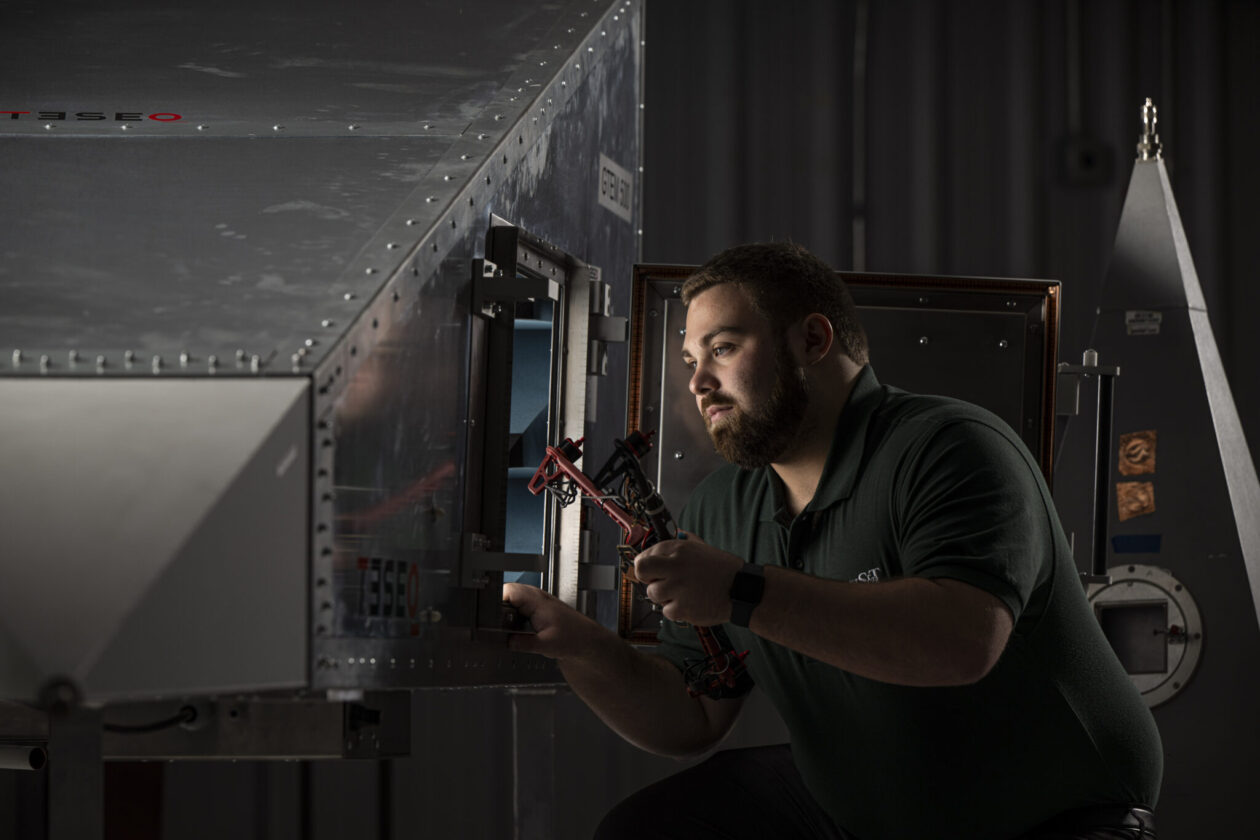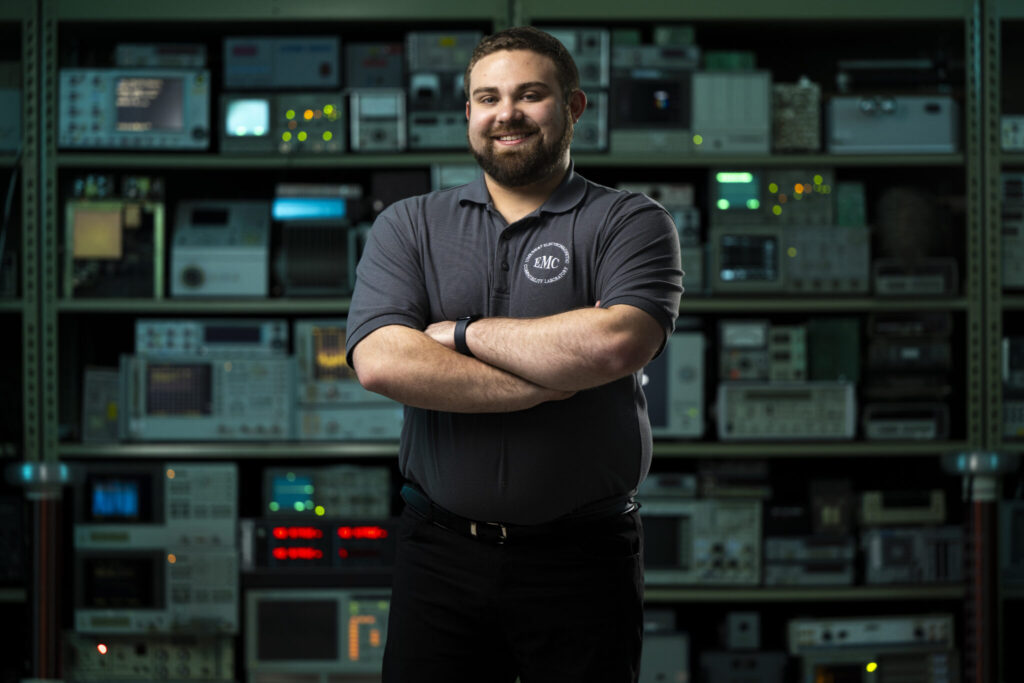Engineers Week: Q&A with Cody Goins, Ph.D. student in electrical engineering
Posted by Greg Edwards

Cody Goins looks in a device used in S&T’s Electromagnetic Compatibility Laboratory for emissions and immunity testing. Photo by Michael Pierce/Missouri S&T.
Cody Goins, of Ozark, Missouri, is a Ph.D. student in electrical engineering at Missouri S&T. He is also an S&T alumnus, earning his bachelor’s degree in electrical engineering in 2022. Here is a Q&A with Goins in commemoration of National Engineers Week 2025.
How would you explain what electromagnetic compatibility means, and why is this important to study?
Electromagnetic compatibility, or EMC, is essentially the study of how to make electronic devices compatible with their electromagnetic environments. Being compatible means that devices can operate without being affected by electromagnetic energy in the environment, and, inversely, don’t interfere with the operation of other devices in their environment.
EMC also provides the electromagnetic analysis that allows the fast communication of a microprocessor to memory and other components in computers. Since lots of complex electronics are operating together in the modern world, EMC is very applicable and is actually required in testing for all commercial electronic products. The work done in EMC allows aircraft to fly safely, new computers to have faster data speeds and ensures that all electronics in the world work how they were intended.
What aspects of your research in electrical engineering and electromagnetic compatibility do you find most fascinating?
EMC can be broken down into many areas, ranging from how to deal with static shocks from someone’s finger to electronics, all the way to studying how signals make it from one end of a printed circuit board to another. I currently work in the electronic susceptibility section of the field, essentially looking at how likely it is that a device could be damaged or be effectively confused when exposed to some electromagnetic fields.
This work has gotten me involved with projects relating to the emerging technology of directed energy, specifically on the high-power microwave (HPM) side. One large challenge is how to predict the effects that will be caused by the high-power fields used. The work I’ve done in this area has been fascinating since the problem is so difficult to solve. Every year, the community gets more innovative, producing more creative solutions, and it has been fulfilling to see the progress made in the roughly two years I’ve been involved.

You are a SMART Scholar with the Air Force Research Laboratory. What does that entail for your time as a student and for after graduation?
The Science, Mathematics and Research for Transformation (SMART) program is through the U.S. Department of Defense (DOD). It pairs students with a sponsoring facility and allows that facility to help guide the research of the student so that the DOD gets experienced students working with them in the future.
Due to my work in the directed energy field, I chose to work with the Air Force Research Laboratory (AFRL) in their directed energy directorate in Albuquerque, New Mexico. As a student, this gives me a chance to work with them every summer on real ongoing projects in the high-power microwave field, as well as have my projects in the EMC lab more aligned with this field. After graduation, I will go to work for AFRL, continuing my work and growing my career with one of the most active government groups in the field. SMART also gives me opportunities after graduation to grow, such as being able to submit proposals for grant money sponsoring research at my facility.
In 2021, you were selected as St. Patrick for Missouri S&T’s St. Pat’s Court, and you have been involved with multiple S&T organizations and events. Why is staying involved like this important to you?
I’m a believer that being involved in organizations in college can be just as important as doing well in coursework. While courses prepare you in a technical sense, organizations help you grow in other ways, ranging from time management to working in groups with diverse opinions. Learning these skills will not only help you stick out to employers but will also help you grow as an individual and be more productive. Through my time on the St. Pat’s Board and other organizations such as Eta Kappa Nu (HKN), I have also met many lifelong friends who I would not have met otherwise.
The 2025 theme for National Engineers Week is “Design Your Future.” How does your work as a Ph.D. student fit with this?
To me, the theme “Design Your Future” refers to not only solving the problems that exist today but considering the ones that will be relevant years from now. As young engineers, we have the power to decide how the future world will look, and we should do our part to design the best world we can. My work as a Ph.D. student allows me to become a leader not only in my specific field, but also in engineering as a whole. Being a leader enables me to make decisions about where current and future research directions will go, and with that, design the best future that I can.
What advice do you have for those interested in studying electrical engineering?
Electrical engineering is a vast field that covers many interesting areas. My advice is to really find what interests you in the field. Talk to faculty and other students about what opportunities are out there and how you can get involved to really discover what you love about the field of electrical engineering. Once you find the area you love, it really starts to become more of a hobby that you enjoy working on every day. If you’re interested in electrical engineering but haven’t committed to the degree yet, I would say go for it. You can work on many interesting problems that truly advance the capabilities of the world in a constantly evolving field.
Leave a Reply